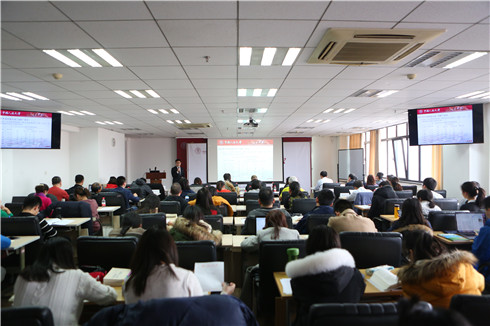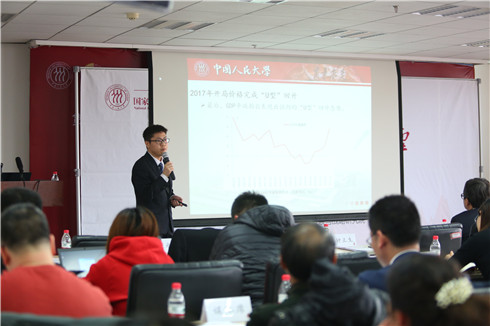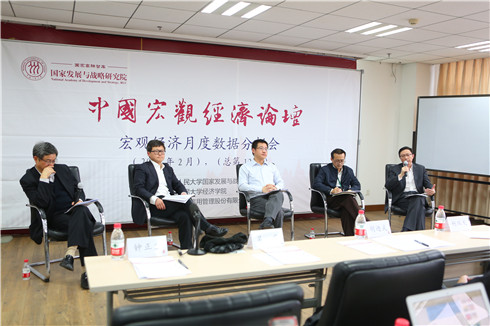 Research Update
Research Update
22
FebOn February 22, 2017, “China Macroeconomic Forum”-Macro Economy Monthly Data Analysis Meeting jointly hosted by the National Academy of Development and Strategy (NADS), the School of Economics of Renmin University of China (RUC) and China Chengxin Credit Management Co., Ltd. was held at RUC. Macroeconomic data for January of 2017 were analyzed and interpreted at the meeting.

Attendees include such experts and scholars as Liu Yuanchun, Vice President of RUC and Executive President of NADS, Wu Qing, Research Fellow of the Development Research Center of the State Council, Zhong Zhengsheng, Managing Director of Caixin Insight Group, Yang Ruilong, Co-director of the Institute of Economic Research of RUC, and Yan Yan, President of China Chengxin International Credit Rating Co., Ltd. and Deputy Co-director of the Institute of Economic Research of RUC.
Liu Xiaoguang, Research Fellow with NADS, released the macroeconomic monthly data analysis report on behalf of the research team. According to the report, China’s economy in the opening of 2017 showed the following latest feature: “U-shape”price recovery. CPI, PPI, import and export prices and comprehensive GDP deflator all showed a perfect “U-shape” tendency.

Opening price for 2017 has achieved a “U-shape” recovery: firstly, in terms of consumption, CPI showed a distinct “U-shape” upturn, for which the possibility that the Spring Festival was the leading factor could be basically ruled out. Secondly, in terms of production, “U-shape” recovery of PPI showed an even more obvious trend. Thirdly, with regards to import and export trade, import and export price index also demonstrated a “U-shape” tendency. Lastly, seen from the whole picture, GDP deflator showed a strong “U-shape” rebound trend.
Current “U-shape” price rebound reflects key changes of economic fundamentals. In the opening of 2017, China’s economy showed a continuous trend of warming up. For starters, the current price recovery reflects economic recovery in China, including the stabilization and recovery of the manufacturing industry. Price recovery also reflects foreign trade recovery for China, with import demand picking up at a relatively high speed. The rally in price also reflects a relative change of market supply-demand structure. In 2016, China’s economic operation stabilized and recovered: the country’s economic growth rate returned to world No. 1. Moreover, economic structural transformation achieved outstanding results: seen from demand structure, reliance level of China’s economy on investment and overseas market demand saw a continuous fall and seen from industrial structure, that on the secondary industry also declined, showing distinct results in industrial transformation and upgrading; new industrial growth points emerged in a consecutive manner; employment saw a stable and upward trend with the growth of the number of migrant workers recovering for the first time; corporate performance was greatly improved; confidence of main market players rose again; and supply-side structural reform achieved substantive progress.
The biggest influence of “U-shape” price recovery on China’s economy is that it saves China’s economy from the pressure of “deflation”. Firstly, price recovery eased the “debt-deflation” pressure. Secondly, price recovery will drive corporate performance improvement. Thirdly, price recovery will mobilize more enterprise investment. Fourthly, recovery of CPI could indicate a relative increase of residents’ living cost. Lastly, price recovery released operation space for monetary policies to prevent asset bubble and address exchange rate depreciation.
The price trend in 2017 poses two core risk points to China’s economic operation. The first one is the rise of “cost-driven” inflation pressure. Particularly, “imported inflation” might exert negative influence on the economy. With PPI dominating the change of price structure and switching positions with CPI, PPI-CPI transmission might accelerate in 2017. The second risk point is the imbalance in price rise at present. Particularly, industry differentiation within the industrial sector is relatively severe and some industries might encounter double pressure from high cost and low price.
By comparing the six phases of price adjustment, the report pointed out that the current price adjustment is already in the transition period from Phase IV to Phase V, meaning that China’s economic bottoming has achieved a true victory and is about to step into a new nodal period. On such basis, the report looked into China’s economic situation in 2017 and predicted a stable and upward one with GDP growth rate reaching 6.5%-7% and CPI increasing by 2.5% -3%.

Guests at the meeting held in-depth discussions and reviews with regards to macroeconomic data of January and the analysis report, expressed their insightful points of view and provided targeted policy advice.